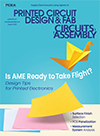Products
The FLX2010 MKL placement machine now comes with a three-head system that performs material dispensing and consecutive placement of LEDs on film substrates. Features a placement axis with an integrated component adjustment mechanism, as well as two independent axes with a piezo flow valve and a time-pressure dispenser gear. Dispensing valves are mounted on motorized, closed-loop driven linear axes. Is said to handle substrates up to 800 x 600 mm. Substrates are vacuum-secured. Vacuum is activated with a foot-operated switch, and the film substrate sticks to the table. A time-pressure dispenser applies three dots of isolating adhesive on the substrate. Solder paste dots are applied on the substrate solder pads using a piezo-controlled PFV nozzle. LEDs are picked from standard feeders, adjusted and placed. The isolating adhesive reportedly eliminates unwanted electrical contact between the solder dots.
Essemtec AG, www.essemtec.com
CircuitSpace v2.2 permits bi-directional communication between layout and a PDF schematic. Is said to provide instant selection and verification of design elements such as components, nets or pins, within Cadence Allegro and schematic. Cross-probing permits populating any selection set through interactive clustering. Is said to reduce board layout and placement time to minutes with AutoClustering, design reuse, and cross-probing. Features concurrent layout development project wide; template generation for global library usage across divisions; template usage with and without etch; automated layout reference designator propagation; advanced sustaining engineering and ECO process; automated change report between layout designs and availability.
DesignAdvance Systems Inc., www.designadvance.com
FLX-CVU comes as an option for the FXL2011 placement machine and verifies component electrical characteristics. Reportedly prevents setup flaws and wrong placement actions as a result of labeling and packing errors, localizes divergences in component reels, and eliminates placement of out-of-spec parts. Measurement values are stored in a database and permit traceability to single parts. Measurement unit is directly integrated into machine; contacts are designed so that components with different outlines and form factors can be tested. Complex adjustments, setup and calibration of test contacts or hooks are said to be unnecessary. The contacting unit is linked to a universal instrument that measures resistance, capacitance and inductance. Measurement takes place immediately after picking from the feeder.
Essemtec AG, www.essemtec.com
Essemtec AG, www.essemtec.com
Press Releases
- Clemsa Achieves up to 75% Faster Changeovers and Higher Quality with Europlacer SMT placement line
- Nordson Test & Inspection to Unveil Next-Generation Inspection and Metrology Technology at SEMICON Taiwan
- AIM Solder Announces New Distribution Partnership with Covermat Co., Ltd. in Thailand
- Automated Production Equipment and Manncorp Announce Strategic Partnership to Expand SMT Solutions for U.S. Electronics Manufacturers


